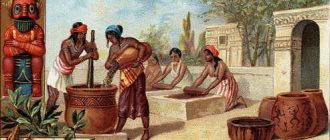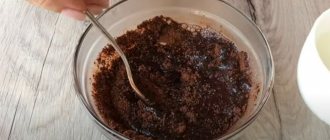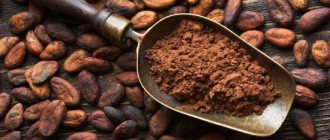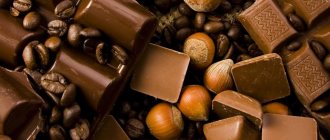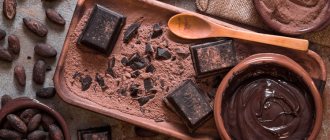Latte is a coffee drink beloved by many, to which, to add new flavors, you can add various syrups and their mixtures (nut, caramel, berry, vanilla, chocolate), everything except citrus and other additives, including alcoholic rum or amaretto. Those with a sweet tooth will surely enjoy a latte with added chocolate.
Lattes should be served in Irish glasses - special glass vessels for hot drinks. As a rule, they are on a low leg and have a handle on the side, also made of glass. For home use, you can use regular tall glasses, not forgetting to insert a straw.
What is Turka
Turkish coffee is brewed in cezves - pear-shaped metal vessels with a narrow neck, thick bottom and long handle. The cezve began to be called Turkish in Russia because of its origin.
At the Sultan's court, the merits of the new drink were appreciated; coffee for the ruler was brewed in golden saucepans with a capacity of one serving. The grains were ground in front of the Sultan, and the dishes with a hot drink were immediately served to the table. Coffee was prepared over coals; if it boiled over, the aroma was spoiled. By order of the Sultan, a vessel made of tinned copper with a thick bottom was invented. Copper takes longer to heat up than gold, the narrow neck does not allow the aroma to dissipate, the cooking process is prolonged, and the drink has time to be imbued with the taste and strength of the ground grains.
Why does coffee sour?
Sometimes a prepared drink has a sour taste, and an unprepared person may think that it is spoiled, which is completely wrong. He probably just hasn’t come across the concept of sourness in coffee yet.
This is a mandatory property of all Arabica beans: the higher the trees grow, the more sour the drink from the beans will be. Robusta does not have this quality.
In addition, the taste of the drink depends on the degree of roasting. If the beans are lightly roasted, then the coffee will definitely be sour, and if the beans have acquired a black tint, then in most cases it will not be sour, but will rather be bitter.
Which type of coffee to choose
Only two of the more than sixty varieties of coffee are of interest to coffee lovers - Arabica and Robusta.
Arabica originates from Ethiopia, but is now cultivated in different parts of the world with suitable climates. Robusta was once discovered in the Congo and spread throughout the tropics of Africa, Indonesia, Vietnam and other countries.
The Arabica variety is more popular because it has a rich taste, aroma and pleasant softness. Robusta has a sharp and bitter taste, which is liked by lovers of strong coffee. Brown Arabica beans are mixed with black robusta in various proportions and get interesting flavors, the desired strength, rich aroma and thick foam on the surface of the coffee.
Varieties of cocoa beans
Another interesting fact about cocoa. Today, only four varieties of cocoa beans are known in the world - Forastero, Criollo, Trinitario and Nacional.
Each of the four varieties has its own taste and aroma, and each variety has its own connoisseurs. Another fact about cocoa is that although there are only four varieties, they have very different sales shares in the world cocoa bean market.
The world leader in sales is Forastero
(Forastero), they account for up to 90% of demand. It is from this variety of cocoa beans that chocolate is produced, which is so loved by the inhabitants of our planet. This variety takes its history from the upper Amazon basin. This variety is grown mainly in Africa, Ecuador and Brazil. Two West African countries - Côte d'Ivoire and Ghana - are currently leaders in the production of this cocoa variety. This cocoa variety is characterized by disease resistance, which attracts cocoa growers, and abundant yield. This variety does not have complex flavor compositions and fruity notes, such as, for example, the Criollo and Trinitario cocoa bean varieties. But it has a richer “chocolate” taste. This property attracts chocolate manufacturers who mix cocoa beans of different varieties to get their “secret” recipe for successful chocolate. In addition, modern chemistry provides various flavor additives to further surprise consumers with a variety of new flavor combinations.
The next variety of cocoa beans with noticeably less demand on the world market is Trinitario
(Trinitario). It accounts for 7% to 15% of demand. Trinitario is grown in countries where Criollo was previously cultivated - Mexico, the Caribbean, Colombia, Venezuela, and parts of Southeast Asia. This variety is interesting because it appeared as a result of crossing naturally using the cross-pollination method. The variety was bred in the 18th century to restore the population of Criollo cocoa trees on the Trinidad Islands, which were almost completely destroyed by an environmental disaster. Trinitario combines the best qualities of the other two varieties: the unpretentiousness and high yield of Forastero, the mild taste of Criollo and, moreover, the abundant content of cocoa butter. This variety has a pleasant smell.
The next variety with even lower sales volumes is the Criollo variety
(Criollo) with a share of 1-5% of the world harvest. This variety is grown in Central and South America, the Caribbean Islands and Sri Lanka. This variety of cocoa beans is considered the best. But despite the excellent taste, the trees produce very little harvest. The taste of the fruit is characterized as delicate, but at the same time unusual, incomparable to the taste of classic chocolate, with a pleasant aftertaste. Criollo cocoa beans are deservedly used as an ingredient in the production of premium quality chocolate.
And the last variety of cocoa is called National
(Nacional) with a share of the world cocoa bean market of a modest 0.1-1%. This variety was discovered in 2011 in Peru. This is a rare species, and it is distinguished by its purity of genetics. Candies made from this variety are rich in creamy taste with a slight bitterness. The taste and aroma of this type of cocoa bean is not as good as that of Forastero, Criollo and Trinitario, but these beans can be used to produce good candies. Additional ingredients used in the production of chocolate from these beans help smooth out the harsh notes and improve the taste of the finished product.
How to brew Turkish coffee: useful tips and tricks
Since the creation of Turks, many models of coffee makers and coffee machines have been created, but Turkish coffee on a regular gas or electric stove has a unique charm that Americano and espresso cannot compare with. Before brewing coffee in a Turk, you should understand some of the intricacies of the process.
The finest grind
Coffee prepared on the stove will retain its beneficial properties as much as possible if you grind the beans almost to powder. Not only the thick consistency and aroma of the drink, but also the density of the foam on the surface depends on grinding. A modern home coffee grinder is suitable for grinding; you need to grind the beans before cooking, and not for future use - when stored for a long time, ground coffee loses its aroma.
Water quantity and quality
The water must be unboiled and clean, filtered. Chilled boiled water is not suitable - this has been tested many times in practice. Pour water up to the neck of the turk, leaving room for foam.
Fire intensity
Turkish coffee at home should be brewed over very low heat. The drink should not boil violently - this will kill the taste and aroma.
Salt and sugar
Sugar, dropped into the cezve at the beginning of preparation, fully reveals the taste of the coffee, helps the foam form, but slows down the process a little. Several salt crystals perform the same task.
Cooking time
You can brew coffee in a Turk on a gas stove until the foam begins to rise. Do not let it boil, otherwise the essential oils will be destroyed.
Ground coffee portion
To prepare a standard 100-gram cup of coffee, one or two spoons of ground coffee is enough. It’s not worth adding more - the taste will not become richer, but bitterness will appear.
Foam
Making Turkish coffee at home requires the formation of foam, which prevents the aroma from evaporating. The foam will be dense if you let it rise a little several times and immediately remove it from the heat. As soon as the foam begins to settle, return the Turk to the stove. It is better not to stir the coffee while brewing so as not to disturb the barrier that preserves essential oils.
Cheerfulness, Hollywood style
This recipe is quite exotic and will not appeal to everyone. However, it has an amazing invigorating effect, and the unusual flavor accent can surprise even gourmets.
Its main ingredients are:
- 2 teaspoons of coffee powder;
- 1 tablespoon cocoa;
- 3 teaspoons of sugar or powdered sugar;
- 150 ml milk;
- 200 ml water;
- some roasted almonds;
- and a pinch of salt.
How to cook:
- Mix cocoa powder with powdered sugar in a small saucepan and pour half of the milk brought to a boil into it.
- The mixture must be stirred until smooth, and only then add the rest of the milk and salt. Place the container on low heat and cook for 10 minutes.
- Meanwhile, prepare strong black coffee and strain it.
- Once the cocoa is cooked, whisk it until it forms a thick foam, then mix both drinks.
Now all that remains is to pour the finished coffee with cocoa into cups, decorate it with cream on top and sprinkle with almonds.
How to make coffee with foam
- To make Turkish coffee at home aromatic, the beans must be ground very finely. A serving of ground coffee per 100-150 ml of water is 2 teaspoons.
- Pour coffee and sugar to taste into the cezve, you can add a pinch of salt to enhance the taste. Fill with cold water up to the neck; the smaller the area of contact between the surface of the coffee and the air, the better the aroma will be preserved.
- Place the turk on low heat. When heated, coffee particles will rise along with the water and gather at the neck into a thin crust. When the coffee starts to boil, foam will form from the crust.
- Make sure that the coffee does not boil over. Light brown foam at the neck of the Turka indicates that the water is about to boil; this cannot be allowed to happen. Remove the Turk from the heat when you see foam.
- Spices can be added when you remove the Turk from the heat for the first time or to a ready-made drink.
- Wait half a minute and return the cezve to the fire, wait for the foam to rise. If you like very strong coffee, repeat the process another time or two.
- The coffee is ready. You can add milk, cognac, lemon, etc. to it.
- You need to pour the finished coffee into a warm cup.
A magical delicacy - a feast for body and soul
Whether or not to add syrups to a drink is up to everyone to decide for themselves, but over the course of a long time, certain generalized ideas have been developed on how to combine a drink that is unsurpassed in taste with other additives. Remarkable fruits ripen in warm countries, because many of their characteristics are the same.
Coffee coupled with chocolate make up a unique duet, which not only dominates in the human mind as an optimistic major, but also actively participates in the positive processes of the whole organism. It is curious that scientists also did not ignore the symbiosis of two plants. After conducting research, they found that, among other goods, chocolate and coffee were included in the “long-livers menu.” They are credited with the ability to restore and prolong the life of damaged cells.
Turkish coffee and chocolate recipes
The combination of coffee and chocolate seems ideal; it has even been noted that chocolate lovers almost always love coffee. The flavors effectively complement and enhance each other, which once again confirms the harmony of the union - the bitterness of the coffee beans is softened by chocolate. Chocolate coffee began to be brewed in Latin American countries, and from there the recipes quickly spread throughout the world.
Coffee with chocolate
- Ground coffee - 2 teaspoons
- 200 ml water
- Dark chocolate – 50 g
- Salt and pepper - optional
Preparation:
- Brew coffee in a Turk.
- When the foam rises for the first time, you can add salt and pepper on the tip of a knife. The spices will bring out the flavor of the coffee, which is especially important if you are using mild Arabica beans.
- Place the cezve on the fire and wait until the foam rises again.
- Remove from heat, pour into cups and sprinkle with grated chocolate.
- Cover the cups with saucers or napkins for a few minutes to allow the chocolate to melt. Stir.
Coffee with chocolate and cinnamon
Cinnamon was the first spice to be added to coffee. The flavors go well together, although this drink has its supporters and opponents.
- 2 teaspoons coffee
- 200 ml water
- 2-3 slices dark chocolate
- 2 tsp. cream
- A pinch of ground cinnamon
- Sugar to taste
Preparation:
- Brew coffee in a cezve, adding cinnamon after the first rise of the foam.
- Melt the chocolate in a water bath.
- Add chocolate to coffee cups and pour cream.
- This coffee can be drunk hot or cold; the drink tastes similar to cappuccino.
Brazilian coffee with milk and chocolate
- 4-5 teaspoons ground coffee
- Glass of cold water (200 ml)
- 180 ml milk
- Dark chocolate bar (100 g)
- Sugar
Preparation:
- Brew strong coffee in a Turkish coffee pot. Bring to a boil three times.
- Break the chocolate and melt in a water bath.
- Heat the milk and pour into the chocolate in a thin stream. Stir constantly. Beat the mixture with a whisk.
- Pour coffee into milk and chocolate.
- Add sugar to taste.
How much cocoa to put in
The Aztec classic recipe, by the way, did not involve boiling cocoa. It was a cold drink; cocoa was poured with cold water and infused. And there was a lot of cocoa, the drink was very thick.
In Europe, cocoa is a much lighter drink. We put about 25 g of cocoa powder per 200 ml of milk. But you can put more cocoa, pour less liquid, and you get a thick, viscous drink: what is usually called hot chocolate. Or you can do the opposite: add less powder, and you get a completely liquid drink.
You just need to keep in mind that cocoa thickens as it cools. You brew it, cool it a little, and suddenly the drink becomes viscous. This is fine.
The Europeans got everything mixed up! What the Indians did with tomatoes, tobacco and cocoa Read more
